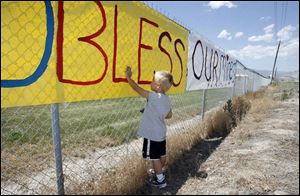
CEO: Rescue operations within about 1,000 feet of trapped miners
8/8/2007
Wylee Sherman, 3, puts a painted handprint to a poster, put up in support of the trapped miners, in Huntington, Utah on Tuesday.
HUNTINGTON, Utah Crews hoping to get food and air to six coal miners drilled to within about 1,000 feet of the trapped men Wednesday, and hoped to reach them in about two days, one of the mine s owners said.
It still wasn t known whether the miners were alive more than two days after the initial cave-in, said Bob Murray, chairman of Murray Energy Corp., owner of the Crandall Canyon mine.
The news was substantially better than the night before, when crews had to halt drilling because of unstable ground.
Efforts to clear tunnels leading to the chamber where the men were believed trapped were to resume in the afternoon, Murray said.
Murray said he invited the son of one trapped miner and the brother of another with him on a trip inside the mine to show them the progress of the rescue efforts.
He also renewed his attacks on media coverage of the disaster and continued to insist the collapse was caused by an earthquake, contradicting seismologists who said the cave-in itself was what registered 3.9 on the Richter scale.
From our mining experience, we know this was an earthquake, Murray said.
It seems to me the media s more concerned about trying to place blame than they are about the families and the actual rescue effort underground, he added.
A spokesman for University of Utah seismologists said Wednesday that all evidence indicates it was the mine collapse, not an earthquake, that registered on a seismograph early Monday, and that scientists suspect further shaking at the site is caused by settling.
Murray insisted the crisis was caused by a natural disaster.
This was caused by an earthquake, not something that Murray Energy ... did or our employees did or our management did, he said. It was a natural disaster. An earthquake. And I m going to prove it to you.
However, seismologists said the mine collapse appeared to be the source, not the result, of the seismic event recorded by seismographs.
Our seismologists at the University of Utah are careful not to rule out any possibility, but they tell me all of the available evidence indicates that the mine collapse itself was the earthquake, Lee Siegel, a University of Utah science news specialist, said Wednesday.
Siegel said seismologists don t know what is actually being felt on the ground at the mine during the rescue attempts but are presuming it s from settling. Eleven aftershocks were recorded in 1 days after the collapse, Siegel said. The largest was magnitude 2.2.
The U.S. Geological Survey also says it appeared the initial tremor was the mine collapse rather than a quake. Mine collapses have a seismic signature distinct from earthquakes because they tend to occur at shallower depths and at different frequencies.
Murray also lashed out at news media for suggesting his men were conducting retreat mining, in which miners pull down the last standing pillars of coal after mining out an area and let the roof fall in.
But Amy Louviere, an MSHA spokeswoman, said retreat mining was going on at the mine in a remote canyon 140 miles south of Salt Lake City. She said that exactly what the miners were doing, and whether that led to the collapse, can be answered only by a full investigation.
Retreat mining has been blamed for 13 deaths since 2000.
The government requires mining companies to submit a detailed plan before beginning the process. Murray Energy submitted such a plan and received approval in 2006, Louviere said.
Read more in later editions of The Blade and toledoblade.com.